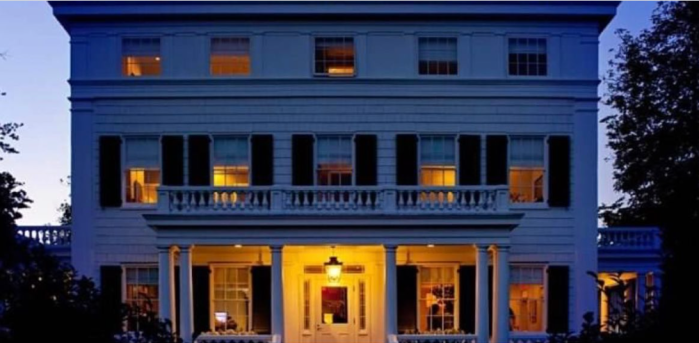West Hampton Dunes Is The Best In The Country!

You are probably aware that Cooper’s Beach in Southampton was rated the #1 beach in America in 2010 and that Main Beach in East Hampton was rated #4. There is a group that rates the top 10 beaches, in order, every year.
What you probably don’t know is that there is another group that rates beaches, but only beaches in America that have been in trouble due to some unexpected calamity but have been restored by the Army Corps of Engineers. This rating competition is to the regular competition what the Handicapped Olympics is to the regular Olympics. Only the disabled can enter. And as far as beaches go, where there are several thousand that compete in the regular competition, only a few dozen beaches are in the restored competition.
It turns out, here in the Hamptons, there is among our many sparkling beaches one that meets the criteria to enter the Restored Beach Competition. It is the four-mile long ocean beach in front of the Village of Westhampton Beach. It existed for several hundred thousand years as a real, God-given beach, but then for a 10-year period during the 1980s and 1990s, it was gone, the victim of a calamity. Now it’s back and being replenished periodically by the Federal government at a total cost of $80 million.
Last week, this beach finished first in the competition for the best restored beach in America, beating out 25 other restored beaches, among them the beach at Panama City, Florida, which finished a close second.
The general public, including this writer because I am on his mailing list, was egged on to make this happen by Gary Vegliante, the esteemed Mayor of the Village of Westhampton Beach. He found out that unlike the regular beach selection process which includes test tubes, sand in laboratories and all sorts of scientific studies, this competition was by popular vote online.
“You know our beach is the best,” Vegilante wrote. “You can vote once a day. Vote often. We’ve got to win this!” There was a link to click. There you could see all the named beaches – Isle of Palms, S.C.; Ocean City, Md.; Pacifica State Beach, Calif.; and of course the hated Panama City Beach, Fla. which, for the entire time of this competition ran neck and neck with West Hampton Dunes right down to the wire, which was April 27, where, finally, uh, West Hampton Dunes put them away.
There was much comment about the competition online where the voting was taking place.
Here are some of the things I read:
“Panama Beach will harass you there if you aren’t of the majority race (White,)” somebody wrote.
“I was treated just fine there,” someone else wrote. “I just came home from that beach. I go there every day.”
The history of the Village of West Hampton Dunes, founded in 1993 and centered around its roughly four mile long beach, has been the subject of several documentaries. Legends have grown up around it. It is arguably the only beach in America that was destroyed by the activities of Hippies in the late 1960s.
In 1969, hippies on Long Island were demonstrating by the thousands against the possibility of a nuclear power plant the Long Island Lighting Company wanted to build in Shoreham. The plant, which was scheduled to cost $800 million, was beginning its construction. There were soon stories about malfunctions, bad concrete, the possibility of a meltdown when it opened. In the end, Shoreham never happened. The hippies and much of the regular population on the island were victorious after the cost of construction passed $6 billion.
A second and lesser known series of demonstrations was also being held against the construction of a proposed 21 stone jetty field that were to be built every quarter of a mile on the ocean beach from the Moriches Inlet going east and ending in Quogue. The construction approved had come about because of the devastating March 1962 Ash Wednesday Storm.
A common sight at that time was of flatbed trucks bringing in enormous boulders from Maine crossing the bridges to Dune Road. But there was talk of the damage being done to the beaches rather than the saving of them. Astonishingly, Suffolk County, which was paying for 9% of this construction (the state way paying 21% and the federal government was paying for 70%), voted to put a stop to it in the middle of it being put in. No one had quite expected that. But what a victory it was for the environment, for the naturalists, the beaches and those gutsy enough to join the marches to end it.
At the point of the stoppage, a little more than half of the jetties were already in place. There was no talk of taking them out. They are there today. And if Herman Bishop Construction had put them in beginning at the Moriches Inlet and headed east with them for every quarter of a mile, none of the subsequent catastrophe that befell Dune Road would ever have happened.
Herman Bishop Construction however, had put the jetties in from east to west. Because this was half the job, they placed the first jetty in what was supposed to be about in the middle of the jetty field when it was finished. This jetty is in front of Westhampton Beach. Then Bishop built the ones that followed to the west.
The disaster came slowly, but could not be stopped. Beginning about 1970, people noticed that just to the west of the most westerly jetty, the sand was beginning to thin and the waves of the ocean were able to crash much closer to the small oceanfront houses that had been built there.
Soon it was determined by scientists what was happening. The drifting of sand along the ocean shore goes from east to west. The 15 jetties to the east of this community were like the teeth of a comb. As the sand came along with the waves, it got caught up in the jetties. This sand, as it was supposed to, was creating millions of pounds of new beach adjacent to the jetties to protect the shoreline. But this was sand that, without the jetties, would have replenished the beaches going out to the west toward the inlet. Since there was now none coming, the beaches were vanishing in front of these houses beginning immediately at the last jetty built.
As the years went by, the ocean came closer and closer until the waves were now under some of the 260 oceanfront homes built along that stretch between Westhampton Beach and the Moriches Inlet. Soon people were beginning to abandon their homes and soon after that, some of them began falling into the sea from the pounding they were taking by the waves. Ultimately nearly 190 homes were washed out. The people who owned them lost everything. They even lost the ground they were sitting on. By 1992, the sea, for lack of a sand barrier to keep it at bay, had washed right through to Moriches Bay. At its worst, this inlet was nearly half a mile wide and all the land was now underwater with the houses gone, and also Dune Road itself, the telephone poles, the sewer lines the telephone lines, the electric lines and everything else. It was a new and very horrendous inlet, with the ocean now threatening the last mile of homes, now isolated on an island that ended, to the west at the Moriches Inlet. These homes also had been abandoned. Without the road, there was no government able to get out there, no police, no ambulances no nothing. Who was getting out there, by boat, and mostly at night, were the vandals. Soon, the 200 homes there were stripped of valuables. Also stripped and mostly demolished was a well known and beloved nightspot on the ocean there called Morgan’s White Cap.
This story just sounds impossible, doesn’t it? An entire community of summer homes, suffering this sort of catastrophe in the Hamptons. But it happened.
Of course, the lawyers had a field day, at least at first. Representing the homeowners whose homes were swept away, the each filed lawsuits against every entity they could think of that had caused this catastrophe. That would include the County of Suffolk, the State of New York, the Federal Government, Herm Bishop Construction and the Town of Southampton. The Village of Westhampton Beach was not sued. The damage done began just to the west of the village line on Dune Road. That portion of Dune Road out to the end was prior to that time under the jurisdiction of Southampton Town.
Within a year, there had been so many lawsuits filed by these poor homeowners, that it was estimated it might take ten years just to untangle them. And legal guesses were that these lawsuits would be going nowhere. At that time, you could buy an underwater, oceanfront former building lot from one of these former homeowners for $5,000.
In 1993, some of the former residents of this now inundated catastrophe got together on dry land to try to think of a new way of tackling this problem. You could ask Mayor Vegliante who the others were, but he was one of them. At the time, he was just the owner of a couple of restaurants in the Bay Shore area who had one of these summer homes there on Dune Road he visited.
As it happened, Vegliante’s home was one of the few that was untouched by the disaster. It stood facing the bay, not the ocean, and it was just adjacent to the last jetty. It was possible to go there, sit out on the deck and look out at everything wiped out to the west.
The idea that created the miracle came from that meeting on Vegliante’s deck. The idea was—what happens if we form an Incorporated Village? There had not been one before. There had been about 230 homes on that peninsula, but now there were maybe five, Vegliante and a few others. That was it.
It was one thing for individuals to petition the federal government about the sea swallowing up your home, a lawyer at this meeting said. It was another entirely if a whole village was wiped out.
The plan was, and this plan succeeded, to create a legal entity on this catastrophe called the Village of West Hampton Dunes, find all the residents up-island who owned the underwater land, have them vote such a village into existence, and then petition the Federal Government. They could write this on official village stationery.
Dear Mr. President: Help! Our village has been wiped out by a natural disaster. We need to be called a disaster area. We need to have our peninsula restored. We need to have our land bolstered up against the sea. Then we can rebuild.
And so the letter went out. Do you think they made this happen? Does a bear pee in the woods? The Federal Government swung into action. There was no FEMA then, but whatever there was it was mobilized and sent in to survey the damage. The feds would prop things up, treat those who were injured and then fix this poor destroyed village. We can’t allow an American village to go down like this!! How old was this village did you say?
Today, the Incorporated Village of West Hampton Dunes is wall to wall million dollar summer homes. They sit behind a dune. The Army Corps also came in with steel sheeting and essentially created a 60-foot deep underpinning so that the island will never come completely apart again. I visited these waters when the Army Corps of Engineers was building this. The bulkheads were being pounded into the sea, giant corrugated steel panels of the sort you might see creating a dryblock inside of which you would repair destroyers or battleships.
Thus did the government re-create everything that got destroyed, and made formerly middle class people with little homes on the beach into formidable millionaires with oceanfront homes on their property.
These homes are also guaranteed never to fall into the sea again. The promise of the Army Corps of Engineers is that every couple of years, for a total of 30 years until 2027 they would be back with millions of tons of sand for this four-mile stretch to replace any that got washed away during the interval.
It’s a compliment from the Village to the Army Corps of Engineers for the Village to win the First Prize in the restored beach competition. There are other restored beaches around the country. Twenty-four of them. But ours is the best.









